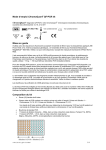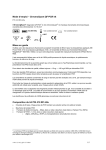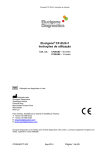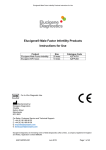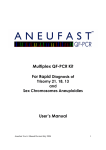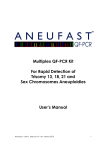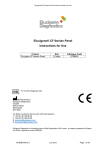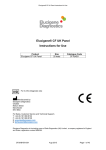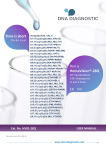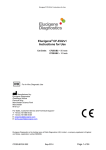Download Elucigene® QST*R-PL (Pregnancy Loss) Assay Instructions for Use
Transcript
Elucigene® QST*R-PL (Pregnancy Loss) Assay Instructions for Use Elucigene® QST*R-PL (Pregnancy Loss) Assay Instructions for Use Cat Code: AN6XYB1 – 25 tests For In-Vitro Diagnostic Use Manufactured by: Elucigene Diagnostics Citylabs Nelson Street Manchester M13 9NQ For Sales, Customer Service and Technical Support:T: +44 (0) 161 669 8122 F: +44 (0) 161 669 8129 E: [email protected] E: [email protected] Elucigene Diagnostics is the trading name of Delta Diagnostics (UK) Limited., a company registered in England and Wales, registration number 8696299. AN6XYB1EN 001 Jan-2015 Page 1 of 37 Elucigene® QST*R-PL (Pregnancy Loss) Assay Instructions for Use Elucigene QST*R-PL Intended Use For the routine in vitro diagnosis of the six most common autosomal trisomies associated with pregnancy loss: trisomy 13 (Patau syndrome), trisomy 15, trisomy 16, trisomy 18 (Edwards’ syndrome), trisomy 21 (Down syndrome) and trisomy 22. The kit also includes X and Y chromosome markers and the TAF9L marker for the determination of sex status. The method employed by the Elucigene QST*RPL kit is the QF-PCR (Quantitative Fluorescence-Polymerase Chain Reaction) technique. The device is intended to be used on DNA extracted from either fetal material obtained post-miscarriage or whole blood (of fetal origin). The intended target population is individuals who have experienced a spontaneous miscarriage. The results obtained from QST*R-PL kit can help determine the aneuploidy status of the fetus and is intended to be used in conjunction with other diagnostic procedures to support or discount the proposed clinical diagnosis. The device is for Professional Use only within a molecular or cytogenetics laboratory environment. Summary and Explanation Statistically, 10-20% of all pregnancies end in spontaneous abortion (miscarriage), the majority of which occur towards the end of the first trimester. Of these, over 50% of cases have been shown to be caused by a chromosome abnormality (1), primarily aneuploidy; the most commonly noted are trisomies, which account for 60% of all chromosome abnormalities in miscarriage. The most frequent trisomy found in products of conception (POC) is trisomy for chromosome 16 however trisomies for chromosomes 13, 15, 18, 21 and 22 are also amongst the most common. Other aneuploidies commonly seen include monosomy X and triploidy which account for approximately 20% and 15% of all abnormalities, respectively. These data are represented in Figure 1 below (2). Figure 1: Showing the chromosomal findings in products of conception with 46N representing normal results. AN6XYB1EN 001 Jan-2015 Page 2 of 37 Elucigene® QST*R-PL (Pregnancy Loss) Assay Instructions for Use Principles of the procedure The method employed by Elucigene QST*R kits uses the QF-PCR (Quantitative FluorescencePolymerase Chain Reaction) technique (3-6). Using PCR amplification, fluorescent dye labelled primers target highly polymorphic regions of DNA sequence called short tandem repeats (STRs) that are located on the chromosomes of interest. Each targeted STR marker is specific to the chromosome on which it is located, thus the copy number of the STR marker can be diagnostic of the copy number of the chromosome. Informative STR markers have been selected that exhibit a high heterogeneity so that copy number can be easily determined. A normal diploid sample has the normal complement of two of each of the somatic chromosomes, thus two alleles of a chromosome specific STR are determined by the QF-PCR technique as two peaks in a 1:1 ratio. The observation of an extra STR allele as either a three peak pattern in a 1:1:1 ratio or two peak pattern in a 2:1 or 1:2 peak ratio is diagnostic of the presence of an additional sequence which in turn may represent an additional chromosome, as in the case of a trisomy. Amplified products of the QF-PCR technique are analysed quantitatively on a capillary electrophoresis Genetic Analyzer to determine the copy number of the analysed STR markers. Warnings and Precautions 1. The normal DNA Control provided in the kits has been independently tested and found to be negative for Hepatitis B Virus (HBV), Hepatitis C Virus (HCV) and Human Immunodeficiency Virus (HIV) 1 and 2. 2. Care should be taken when handling material of human origin. All samples should be considered potentially infectious. No test method can offer complete assurance that HBV, HCV, HIV or other infectious agents are absent. 3. Handling of samples and test components, their use, storage and disposal should be in accordance with the procedures defined by the appropriate national biohazard safety guideline or regulation. 4. In line with current good laboratory practice, laboratories should process their own internal QC samples of known type in each assay, so that the validity of the procedure can be assessed. 5. If kit box is damaged, there may be damage to the contents, do not use the kit, contact Customer Service. AN6XYB1EN 001 Jan-2015 Page 3 of 37 Elucigene® QST*R-PL (Pregnancy Loss) Assay Instructions for Use Symbols used on labels The symbols used on all labels and packaging conform to the harmonised standard ISO 15223 Manufacturer Number of tests See Instructions for Use X°C Store below temperature shown Use before date shown Catalogue code Lot or batch number In Vitro Diagnostic Medical Device AN6XYB1EN 001 Jan-2015 Page 4 of 37 Elucigene® QST*R-PL (Pregnancy Loss) Assay Instructions for Use Materials Provided Store all components below -20°C The Elucigene QST*R-PL IVD kit contains: 450089 1 x 250µl Reaction Mix (TA) 404485, 1 x 50µl Control DNA (DC) Sufficient for 25 tests. Kit Preparation and Storage Upon opening the kit it is recommended that the reaction mix be dispensed into 0.2ml PCR vials in 10µl volumes and frozen at -20°C. Ensure that vial contents are thoroughly thawed and mixed before dispensing. The Control DNA should be frozen at -20°C. Materials required but not provided General Laboratory consumables – gloves; screw-capped microfuge tubes; 0.2ml PCR vials or microtitre plates recommended by the manufacturer of the thermal cycler used; pipette tips. Laboratory equipment – precision pipettes (2 sets: 1 for pre-amplification and 1 for post-amplification handling; preferably positive displacement pipettes); protective clothing; vortex mixer; microfuge; 96well microtitre plate centrifuge. PCR Amplification Thermal cycler to accommodate 96-well microtitre plates or 0.2ml vials with a temperature accuracy of +/-1°C between 33°C and 100°C and static temperature uniformity of +/-1°C. QST*R-PL has been validated and shown to perform to specification on the following recommended Thermal Cycler platforms: Life Technologies GeneAmp 9700 Life Technologies Veriti Dx (Running in Standard mode) Life Technologies Veriti Dx (Running in 9700-simulation mode) Life Technologies Proflex (Running in Standard mode) Life Technologies Proflex (Running in 9700-simulation mode) Note: Peak signal intensities may increase when using the Veriti and Proflex thermal cycler platforms compared to the GeneAmp 9700 platform. AN6XYB1EN 001 Jan-2015 Page 5 of 37 Elucigene® QST*R-PL (Pregnancy Loss) Assay Instructions for Use Capillary Electrophoresis Capillary Electrophoresis –GeneScan 500 LIZ size standard (ABI Cat No 4322682), POP-7 Polymer (ABI Cat No 4352759), DS-33 (dye set G5) matrix standard (ABI Cat No 4345833), 10x Genetic Analyzer Buffer (ABI Cat No 402824) and Hi-Di Formamide (ABI Cat No 4311320). Applied Biosystems ABI 3130 and 3500 Genetic Analyzers (with current Data Collection software), 36cm capillary array (50cm capillary array for 3500 Genetic Analyzer), 96-well optical plates, 96-well septa, 96-well cassettes. Data Analysis One of the following data analysis software packages is required: GeneMapper 4.1 (Applied Biosystems Inc.) or above or GeneMarker 1.65 (SoftGenetics LLC) or above. Additional Elucigene QST*R Documentation These Instructions for Use include a basic section on interpretation of the results obtained in addition to a guide to software analysis with both the GeneMapper and GeneMarker packages. A supplemental Guide to Interpretation with examples and glossary are available from the Elucigene website: www.elucigene.com. DNA Extraction A DNA Extraction method to yield PCR amplifiable quality DNA at a concentration of 0.5ng/µl to 4ng ng/µl. DNA Concentration Using the recommended PCR conditions and sample injection settings* stated in the capillary column run module (page 9), optimal results are obtained with an input DNA amount of 2.5ng. However interpretable results are obtained with input DNA range of 1.25ng to 10ng. *Note: sample injection settings can be modified to suit the amount of amplicon produced during the PCR reaction which can vary due to amount of input genomic DNA added. Less amplicon can be applied to the column for analysis by reducing time of injection. Conversely, more amplicon can be applied to the column for analysis by increasing either time or voltage of injection. Previously amplified samples can be re-injected multiple times for re-analysis. AN6XYB1EN 001 Jan-2015 Page 6 of 37 Elucigene® QST*R-PL (Pregnancy Loss) Assay Instructions for Use Test Protocol Amplification Procedure Note: to minimise the risk of contamination, steps 3 - 5 must be carried out in an area free from DNA. Steps should also be taken to avoid contamination with PCR product. 1. Program the thermal cycler for a single step cycle to activate the DNA polymerase at 95°C for 15 minutes linked to an amplification cycling program of 30 seconds at 95°C (denaturation), 1 minute and 30 seconds at 59°C (annealing) and 1 minute and 30 seconds at 72°C (extension) for 26 cycles. This should be linked to a 30 minutes time-delay file at 72°C (extension) on the final cycle 2. A negative (water) control must be included in each PCR run. It may also be considered appropriate to include other controls, e.g. positive normal (DNA control supplied) and positive trisomy control (DNA not supplied). 3. Thaw sufficient vials of pre-aliquoted QST*R-PL reaction mix for the number of samples and controls to be run (see note under Materials Provided) and centrifuge the vials at 12,000g for 10 seconds. 4. Using separate pipette tips, add 2.5µl of test DNA to a sample vial containing 10µl QST*R-PL reaction mix and mix by pipetting up and down. Do this for all samples to be tested. 5. Do not add DNA to the PCR vial for the negative control; instead add 2.5µl of sterile distilled water. 6. Briefly centrifuge the vials until all liquid is at the bottom of each vial. 7. Place all vials firmly in the thermal cycler block. Initiate the 95°C activation program followed by the amplification program (see step 1). 8. On completion of the amplification program the samples may be stored at room temperature overnight or at 2-8°C for up to 7 days before analysis by capillary electrophoresis. AN6XYB1EN 001 Jan-2015 Page 7 of 37 Elucigene® QST*R-PL (Pregnancy Loss) Assay Instructions for Use Capillary Electrophoresis It is recommended that each user ensure that the chosen equipment is used according to the manufacturer’s instructions and is compatible with this test. In this context the key parameters are the polymer and the capillary array. Optimal results can be obtained using the following capillary electrophoresis conditions on an ABI3130 or ABI3500 Genetic Analyzer. 1. Combine 6.85µl of size standard with 250µl Hi-Di Formamide and mix thoroughly (sufficient mix for 16 wells). Dispense 15µl of the mix into the required number of wells of a 96 well optical plate*. 2. Add 3µl of test sample PCR product to the size standard mix (from step 1) already dispensed into the plate and mix using the pipette. Seal the plate. 3. Denature the PCR product dispensed into the optical plate on a thermal cycler using the following parameters: 94°C for 3 minutes linked to 4°C for 30 seconds. 4. Centrifuge the plate at 1,000g for 10 seconds to remove any bubbles in the wells and load onto the Genetic Analyzer. *Note: It is essential that unused wells (i.e. wells in which No DNA sample is loaded) are still loaded with Hi-Di Formamide to ensure that the capillaries do not dry out. Post-PCR Data Analysis ABI3130 GENETIC ANALYZER Create a sample sheet using the 3130 data collection software with the following settings: • Sample Name: this must be the same sample specific name or number. • Run owner: select the default owner for lab. • Run Protocol: QSTR (contains QST*R 3130 run module – see below)*. *Note: It is necessary to create a run module detailing the instrument settings and subsequently assign this to a Run protocol in which Dye set G5 has been selected. For more information on creating run modules please refer to your instrument user manual. AN6XYB1EN 001 Jan-2015 Page 8 of 37 Elucigene® QST*R-PL (Pregnancy Loss) Assay Instructions for Use 3130 RUN MODULE FOR POP7 POLYMER 36cm Capillary Module: QSTR # 1 2 3 4 5 6 7 8 9 10 11 12 Parameter Name Oven Temperature Poly_fill_Vol. Current Stability PreRun_Voltage Pre_Run_Time Injection_Voltage Injection_Time Voltage_Number_of_Steps Voltage_Step_Interval Data_Delay_Time Run_Voltage Run_Time Value 60 6500 5.0 15.0 180 3.0 15 20 15 60 15.0 1200 Range int 18…65 Deg.C 6500…38000 steps int 0…2000 uAmps 0…15 kvolts 1…1000 sec. 1…15 kvolts 1…600 sec. 1…100 nk 1…60 sec. 1…3600 sec. 0…15 kvolts 300…14000 sec. ABI3500 GENETIC ANALYZER A QST*R Instrument Protocol needs to be created which can then be used for each QST*R run. Create the QST*R Instrument Protocol through the 3500 Instrument Protocols library. Ensure the following are selected: • Run Module: FragmentAnalysis50_POP7 • Enter the settings detailed in the image below: To run the samples create a sample plate by clicking on ‘Create Plate from Template’ in the ‘Dashboard’, ensure the correct Instrument Protocol for QST*R has been assigned (see above). AN6XYB1EN 001 Jan-2015 Page 9 of 37 Elucigene® QST*R-PL (Pregnancy Loss) Assay Instructions for Use Analysis and Interpretation of Results It is recommended that each laboratory develops its own interpretation and reporting procedures and criteria. Best practice guidelines for QF-PCR have been documented by the UK’s Association for Clinical Genetic Science and are available for reference at: www.acgs.uk.com PCR products are observed as a 5 dye labelled system using filter set G5. Filter set G5 detects the 6FAM (blue), VIC (green), NED (yellow) and PET (red) labelled fragments plus the Size Standard marker labelled with LIZ (orange) on an electrophoretogram and in the GeneMapper or GeneMarker program. A QST*R Guide to Interpretation is available from the Elucigene website: www.elucigene.com. Important Note: different combinations of instrument, polymer and size standard may cause the size calling to vary slightly. During validation of the kit, users should check that the default bin settings result in accurate peak labelling and adjust if necessary. In case of any difficulty, please contact Technical Support ([email protected]) for advice. General analysis guidelines for QST*R-PL 1. The negative control should show no sharp peaks within the read range of 100 to 510bp. 2. The positive control must show the expected results and all peaks must meet the criteria below. 3. For analysis of DNA samples at least 1 peak should be observed for each marker tested. The acceptable range for marker peaks analysed on the 3130 Genetic Analyzer is between 50 and 6000 relative fluorescent units (rfus) and for the 3500 Genetic Analyzers is between 175 and 32000 rfus. Peak heights falling outside this range must not be analysed. 4. Electrophoretograms of poor quality due to excessive bleed-through between dye colours (also known as ‘pull-up’) or ‘electrophoretic spikes’ (sharp peaks present in more than one dye) should not be interpreted. The PCR products should be re-injected and re-analysed. 5. Analysis is performed by assessment of peak ratios (A1/A2), where A1 is the peak area of the shorter length fragment and A2 is the peak area of the longer length fragment. The resulting ratio is indicative of locus copy number. For disomic chromosomes heterozygous markers should show two peaks with similar heights. A complete analysis of chromosome copy number status is performed by comparison of peak area ratios. 6. Heterozygous di-allelic (i.e. two alleles) markers should fall within a ratio window of 0.8 to 1.4. However, for two alleles separated by more than 24bp in size a ratio of up to 1.5 is acceptable. Any values falling within this region are referred to as having a ratio of 1:1. If the ratio balance falls out of this window then it may be due to a number of factors, such as: Whole chromosome trisomy Partial chromosome trisomy (including sub-microscopic duplications) Mosaicism Contaminating second genotype (e.g. maternal, twin, external) Stutters causing skewing Preferential amplification of one allele causing skewing Primer site polymorphisms Somatic microsatellite mutations AN6XYB1EN 001 Jan-2015 Page 10 of 37 Elucigene® QST*R-PL (Pregnancy Loss) Assay Instructions for Use The Guide to Interpretation gives examples of typical profiles for many of these. Homozygous markers are uninformative since a ratio cannot be determined. 7. To interpret a result as abnormal (i.e. trisomy present), at least two informative markers consistent with a tri-allelic genotype are required with all other markers being uninformative. It is not recommended to interpret a result as abnormal based on information from only one marker. If required, follow-up testing with the single chromosome kits (i.e. Elucigene QST*R-13, Elucigene QST*R-18, Elucigene QST*R-21) may provide sufficient information for interpretation. Trisomy is determined by either:7.1. Two peaks of uneven height due to one of the peaks representing two alleles which are common to one or both parents. In this case the ratio between the two peaks will be classed as 2:1 or 1:2 such that A1/A2 will give a result in the region of 1.8 to 2.4 when the peak representing the shorter length allele is greater in area than the peak representing the longer length allele, or where A1/A2 will give a result in the region of 0.45 to 0.65 when the peak representing the shorter length allele is smaller in area than the peak representing the longer length allele. 7.2. Three peaks of comparable height present. The ratio of the peaks will be classed as 1:1:1 and their values fall within the normal range of 0.8 – 1.4 (although for alleles separated by more than 24bp an allele ratio of up to 1.5 is acceptable). If this does not occur then it may be due to one of the factors mentioned in step 6. 8. To interpret a result as normal, at least two informative markers consistent with a di-allelic genotype are required with all other markers being uninformative. A normal result indicates the normal complement of two for the chromosome tested. 9. Peak area ratios that fall between the normal and abnormal ranges are classed as inconclusive. Inconclusive results may be resolved by using the single chromosome kits. 10. If both normal and abnormal allele patterns are obtained for a single chromosome then it is recommended that follow-up studies are carried out to identify the reason for the discrepant results prior to any conclusions being reached. 11. In rare cases allele size ranges for markers may overlap. If this is suspected, analysis with the single chromosome kits may resolve this. Analysis of Sex chromosome markers AMEL, TAF9 and SRY:- 1. The AMEL marker amplifies non-polymorphic sequences on the X (104bp) and Y (110bp) chromosomes and can be used to determine the presence or absence of a Y chromosome and represents the relative amount of X to Y sequence. Please note that on rare occasions amplification failure due to mutation of the AMEL-Y sequence has been reported. 2. TAF9L is an invariant paralogous marker with sequences on chromosomes 3 and X. The chromosome 3 specific peak (116bp, representing 2 copies of chromosome 3) can therefore be used as a reference peak to assist in the determination of the number of X chromosomes present (121bp peak). Analysed in combination with Amelogenin and the other sex chromosomes markers, it is particularly useful in the detection of sex chromosome aneuploidy. In a normal female the markers should fall within a ratio window of 0.8 to 1.4. In a normal male the markers will give a ratio ≥1.8. Further details on the interpretation of the TAF9L marker can be found in the Guide to Interpretation. 3. The Y-specific marker, SRY, will give a single peak in normal males and will not amplify in normal females. AN6XYB1EN 001 Jan-2015 Page 11 of 37 Elucigene® QST*R-PL (Pregnancy Loss) Assay Instructions for Use Performance Characteristics INTERNAL VALIDATION 125 fetally derived tissue samples were tested using Elucigene QST*R-PL. Of these, 34 were normal/XY, 40 were normal/XX, 5 were T22/XY, 1 was T22/XX, 3 were T21/XY, 4 were T21/ XX, 3 were T18/XY, 5 were T18/XX, 6 were T16/XY, 2 were T16/XX, 1 was T15/XY, 1 was T15/XX, 2 were T13/XY, 2 were T13/XX, 7 were Monosomy X, 8 were triploid for all chromosomes tested. One sample gave an uninformative result due to homozygosity within the marker set. This sample was subsequently analysed using QST*R-18 and was shown to be T18/XX. All analysable results showed 100% concordance with results previously obtained by alternative, established methods. AN6XYB1EN 001 Jan-2015 Page 12 of 37 Elucigene® QST*R-PL (Pregnancy Loss) Assay Instructions for Use GeneMapper Analysis Guide Note: The following GeneMapper screen shots are taken from GeneMapper v5.0 Importing and Analysing QST*R Files 1. Open the GeneMapper Program file 2. Click in order to add data files to a new project. Navigate to where the raw .fsa data files are stored, highlight the appropriate data files and click the ‘Add to List>>’ button. 3. The run folder will now appear in the ‘Samples to Add’ window. Double clicking on the run folder icon in this window will show each .fsa file to be imported. Samples are then added by clicking at the bottom of the screen. The data files now appear within the GeneMapper main screen (figure 2) Figure 2: Samples ready to add to project AN6XYB1EN 001 Jan-2015 Page 13 of 37 Elucigene® QST*R-PL (Pregnancy Loss) Assay Instructions for Use Importing QST*R GeneMapper Analysis Settings in GeneMapper Manager It is necessary to import the QST*R settings for GeneMapper. This process is controlled through the ‘GeneMapper Manager’ interface. QST*R GeneMapper settings are available from the Elucigene website: www.elucigene.com/product-category/rapid-aneuploidy-analysis/ 1. Open ‘GeneMapper Manager’ by clicking on the icon. 2. Select the ‘Analysis Methods’ tab and then click the import button 3. Navigate to and import the required QST*R Analysis Settings file(s) (3130 or 3500) 4. Repeat the process, selecting the appropriate tab and importing the corresponding file for: Table Settings Plot Settings Size Standards Note: Cluster Plot Settings, Matrices, SNP Sets and Report Settings do not require file imports. Importing QST*R-PL Panel settings in Panel Manager It is necessary to import the QST*R-PL panel and bin settings for GeneMapper. This process is controlled through the ‘Panel Manager’ interface. QST*R-PL specific GeneMapper panel and bin settings files are available from the Elucigene website: www.elucigene.com/product-category/rapid-aneuploidy-analysis/ 1. Open Panel Manager Program by clicking on the icon. 2. Click ‘Panel Manager’ on the left navigation window. Panel Manager will now appear highlighted in blue. 3. Select ‘File/Import Panels’. Navigate to and import the GeneMapper panel file ‘QSTRPL Panel.txt’ (Figure 3). 4. The panel file will now be displayed on the left navigation window. Click on the panel file ensuring that it is highlighted blue. 5. Select ‘File/Import Bin Set’. Navigate to and import the GeneMapper bin file ‘QSTRPL Bins.txt’ (Figure 4). 6. Click ‘Apply’ then click ‘OK’. AN6XYB1EN 001 Jan-2015 Page 14 of 37 Elucigene® QST*R-PL (Pregnancy Loss) Assay Instructions for Use Figure 3: Importing QST*R-PL Panel File Figure 4: Importing QST*R-PL Bin File AN6XYB1EN 001 Jan-2015 Page 15 of 37 Elucigene® QST*R-PL (Pregnancy Loss) Assay Instructions for Use Modifying the Analysis Parameter file It may be necessary to modify the default ‘Analysis Ranges’ in the QST*R analysis settings to account for local variance in run conditions. The minimum analysis range will depend on the capillary and polymer being used during data collection. To view current analysis settings: 1. Open ‘GeneMapper Manager’ by clicking on the icon. 2. Select the ‘Analysis Methods’ tab. The Imported QST*R file will be listed as ‘QSTR Analysis v02’. 3. Click on ‘QSTR Analysis v02’. The row will now appear highlighted. 4. Click the ‘Open’ button and select the ‘Peak Detector’ tab (Figure 5) By default the analysis ranges are set to start at 2,000 and finish at 18,000. Figure 5: Analysis Ranges. AN6XYB1EN 001 Jan-2015 Page 16 of 37 Elucigene® QST*R-PL (Pregnancy Loss) Assay Instructions for Use To find the correct analysis range for your laboratory: 1. From the main GeneMapper window, double click on the imported Run Folder to view the list of .fsa files it contains. 2. Select an .fsa file. 3. Clicking the ‘Raw data’ tab will display the electropherogram of the raw data. 4. Using the first peak of the size standard (e.g. 75bp of GS500LIZ) as a guide, select on a data point approximately 100 data points larger (Figure 6). This determines the lowest point in the analysable range. 5. Ensure the maximum analysis range encompasses the largest peak of the size standard (e.g. 500bp of GS500LIZ or 600bp of GS600LIZv2). 6. Input the new values into the QST*R Analysis file (accessing it as described above). Figure 6: Finding the minimum range using sample raw data AN6XYB1EN 001 Jan-2015 Page 17 of 37 Elucigene® QST*R-PL (Pregnancy Loss) Assay Instructions for Use Analysis of Imported QST*R-PL Files 1. In the main GeneMapper window select the ‘QST*R Table Settings v02’ (Figure 7) Figure 7: Setting QST*R table settings 2. Under ‘Analysis Method’ select ‘QSTR Analysis v02’. Fill down each column by pressing ‘Ctrl+D’. Repeat this process selecting ‘QSTR-PL’ for under the ‘Panel’ heading and ‘QSTR’ under the ‘Size Standard’ heading. Each time remember to fill down by pressing ‘Ctrl+D’ to ensure each setting is applied to the full list of samples. 3. Click to initiate sample analysis. Assign a project name when prompted. Reviewing QST*R Data 1. Select the sample for analysis (highlight sample row). 2. Click to ‘Display Plots’. 3. Select the ‘QST*R Plot settings’ (Figure 8). Figure 8: QST*R Plot settings, drop down menu. 4. The plot window will display sample profile with the tabulated data (Figure 9). A maximum of two peaks for each marker will be labelled automatically by GeneMapper. If three alleles are present for a marker, the third unlabelled peak should be manually labelled (see: Manual Editing of Profiles, below). Note: Allele size ranges for each marker are based on previously observed data. Rare alleles may fall outside the given marker size range and it may be necessary to adjust the bin set accordingly. 5. It is recommended that the plot window has ‘Single click editing’ activated. To do this select ‘Alleles/set click editing’ and ensure that this option is checked. AN6XYB1EN 001 Jan-2015 Page 18 of 37 Elucigene® QST*R-PL (Pregnancy Loss) Assay Instructions for Use Figure 9: Sample Plot window displaying labelled trace data and correlating genotype table Manual Editing of Profiles WARNING! GeneMapper will only assign labels for up to 2 peaks per marker. Manual editing of profiles may therefore be required, i.e. when assigning labels to 3rd peaks (if present) or removing labels from stutter peaks. To add a peak label; left click on the unlabelled peak. You will get the option to add allele comment. Click ‘OK’. The peak will now be labelled with its size in base pairs and its peak area. The table will automatically incorporate the newly labelled peak. To remove a peak label; left click on the peak label. You will get the option to delete allele comment. Click ‘OK’. The peak label will now be removed. The table will automatically remove the deleted peak data. Copying Table Data 1. Highlight all rows with the table at the bottom of the plot window. 2. Copy the selected rows by typing ‘Ctrl+C’ keys. AN6XYB1EN 001 Jan-2015 Page 19 of 37 Elucigene® QST*R-PL (Pregnancy Loss) Assay Instructions for Use QST*R-PL Report Template The associated QST*R-PL report template can be used to determine the peak ratios for a marker and assist in analysis of data. The QST*R-PL specific Report Template is available from the website: www.elucigene.com/product-category/rapid-aneuploidy-analysis/ 1. Open the QST*R-PL Report Template file (QSTR-PL Report Template.xlsm). 2. If the Report Template displays a warning indicating that macros have been disabled, click the ‘Enable Content’ button to enable macros (Figure 10). Figure 10: Enabling macro function in QST*R-PL Report Template 3. If a security warning is shown (as seen in Figure 11), click Yes in order to proceed. Figure 11: Allowing security access 4. Paste the data copied from the GeneMapper data table (see above, ‘Copying Data Table’) using ‘Ctrl+V’ into the top left cell in the outlined area (See Figure 12). AN6XYB1EN 001 Jan-2015 Page 20 of 37 Elucigene® QST*R-PL (Pregnancy Loss) Assay Instructions for Use Figure 12: Importing raw GeneMapper data into the QST*R-PL Report Template. 5. The calculated ratios for each marker will now be shown in the data table to the left. The data table can be printed or saved as a new file for each specific sample. 6. In order to process subsequent samples it is important that all data is fully cleared from the report template. In order to do this, click the ‘CLEAR DATA’ button located underneath the raw data table within the QST*R-PL Report Template. New sample data can now be imported following the procedure outlined above. AN6XYB1EN 001 Jan-2015 Page 21 of 37 Elucigene® QST*R-PL (Pregnancy Loss) Assay Instructions for Use Scoring the Report 1. Trisomy is determined by either:a. Two peaks of uneven height due to one of the peaks representing two alleles which are common to both parents. In this case the ratio between the two peaks will be classed as 2:1 or 1:2. Where A1/A2 will give a result in the region of 1.8 to 2.4 when the peak representing the shorter length allele is greater in area than the peak representing the longer length allele, or where A1/A2 will give a result in the region of 0.45 to 0.65 when the peak representing the shorter length allele is smaller in area than the peak representing the longer length allele. In both cases ‘Ratio’ will appear in the ‘Warning’ column. b. Three peaks of comparable height present. The ratio of the peaks will be classed as 1:1:1 and their values fall within the normal range of 0.8 – 1.4 (although for alleles separated by more than 24bp an allele ratio of up to 1.5 is acceptable). In this case ‘3 Alleles’ will appear in the ‘Warning’ column. 2. To interpret a result as abnormal (i.e. trisomy present), at least two informative markers consistent with a tri-allelic genotype are required with all other markers being uninformative. It is not recommended to interpret a result as abnormal based on information from only one marker. 3. To interpret a result as normal, at least two informative markers consistent with a diallelic genotype are required with all other markers being uninformative. A normal result indicates the normal complement of two for the chromosomes tested. 4. Peak area ratios that fall between the normal and abnormal ranges are classed as inconclusive. Inconclusive results may be resolved by using the single chromosome kits. In the absence of any peak data for a marker ‘Absent’ will be displayed in the warning column. This warning will be routinely observed in the absence of Y chromosome markers. AN6XYB1EN 001 Jan-2015 Page 22 of 37 Elucigene® QST*R-PL (Pregnancy Loss) Assay Instructions for Use GeneMarker Analysis Guide Note: The following screen shots have been taken from GeneMarker v2.6.3. Adding Sample Files to GeneMarker Open the GeneMarker program file and when prompted, select ‘Open Data’. The Open Data Files box will appear. Click the ‘Add’ button. The Open dialog will appear. Navigate to directory containing raw data files; 1. Select all files by CTRL+A or use CTRL and/or SHIFT keys to select individual samples. 2. Click ‘Open’ button in the Open dialog The files selected will appear in the Data File List field (Figure 13). Figure 13: Samples added to the Data File list. Click ‘OK’ button in the Open Data Files box and the samples will be uploaded to GeneMarker. The software will then automatically open the Raw Data Analysis window (Figure 14). AN6XYB1EN 001 Jan-2015 Page 23 of 37 Elucigene® QST*R-PL (Pregnancy Loss) Assay Instructions for Use Figure 14: Raw Data Analysis Window AN6XYB1EN 001 Jan-2015 Page 24 of 37 Elucigene® QST*R-PL (Pregnancy Loss) Assay Instructions for Use Importing QST*R-PL GeneMarker Panel Settings It is necessary to import the QST*R panel settings for GeneMarker. This process is controlled through the ‘Panel Editor’ interface. QST*R-PL GeneMarker panel settings are available from the Elucigene Website: www.elucigene.com/product-category/rapid-aneuploidy-analysis/ 1. Open ‘Panel Editor’ from the ‘Tools’ drop-down menu (Figure 15). Figure 15: Selecting Panel Editor 2. Select ‘Import Panels’ from the ‘File’ drop-down menu (figure 16) Figure 16: Importing Panels 3. Navigate to and import the panel QSTR-PL.xml 4. Repeat the process as required for other relevant panel files. AN6XYB1EN 001 Jan-2015 Page 25 of 37 Elucigene® QST*R-PL (Pregnancy Loss) Assay Instructions for Use Processing Data After the raw data files have been uploaded to GeneMarker, they are ready to be processed. The processing step includes application of a sizing standard, filtering of noisy peaks, and comparison to a known allelic panel if desired. GeneMarker combines all these steps in one simple tool called the ‘Run Wizard’ (Figure 17). To access the Run Wizard simply click the ‘Run Project’ icon in the main toolbar. Run Wizard – creating a Run Template It is necessary to create a run template the first time this software is used to analyse QST*R-PL data. This is done through the Run Wizard; 1. To access the Run Wizard simply click on the ‘Run Project’ icon in the main toolbar. 2. Assign a Template Name e.g. QSTR-PL. 3. Select the Panel, Size Standard, Standard Colour and Analysis Type as shown in Figure 17 below. 4. Click ‘Save’ to store the template for future analyses. 5. Click ‘Next’ to continue. Figure 17: Run Wizard – Template Selection Window AN6XYB1EN 001 Jan-2015 Page 26 of 37 Elucigene® QST*R-PL (Pregnancy Loss) Assay Instructions for Use Run Wizard – Data Process The Data Process window of Run Wizard allows the user to select the peak filtering parameters. 1. Select the appropriate analysis settings in the Data Process window as shown in the figure below (Figure 18). 2. Click ‘Next’ to continue Note: The analysis range setting within the raw data analysis bow will vary depending on the Polymer used during data collection. The operator should select a start data point value that includes the 75bp size standard peak. Figure 18: Run Wizard – Data Process Window Note: For 3500 data, increase the Minimum Intensity to 150 AN6XYB1EN 001 Jan-2015 Page 27 of 37 Elucigene® QST*R-PL (Pregnancy Loss) Assay Instructions for Use Run Wizard – Additional Settings There are no additional settings required when performing QST*R analysis (Figure 19). 1. Click ‘OK’ to continue. Figure 19: Run Wizard – Additional Settings Data Processing Box After clicking ‘OK’ in the Run Wizard Additional Settings box, the Data Processing box appears (Figure 20). The raw data is processed and sized, then the filtering parameters and the selected QST*R Panel are applied. 1. Click ‘OK’ in the Data Processing box when analysis is complete. Figure 20: Data Processing Box AN6XYB1EN 001 Jan-2015 Page 28 of 37 Elucigene® QST*R-PL (Pregnancy Loss) Assay Instructions for Use Main Analysis Window The Main Analysis window (Figure 21) of GeneMarker has an easy to use layout. This layout includes: The sample files list - displayed on the left side of the window. The Synthetic Gel Image - displayed at the top of the window. Data Electropherograms - below the gel image. A Report Table - displayed on the right side of the window. In this window it is important to check that all the appropriate peaks in each profile have been called correctly. 1. Double-click on each sample in turn in the sample file tree on the left-hand side of the screen. Right-click on any peaks in question and choose from the options in the dialogue box e.g. edit or delete allele, confirm or unconfirm as appropriate. 2. From the Main Analysis window select the ‘Applications’ drop down menu option from the top of the screen. Select ‘Trisomy Analysis’. The Trisomy Analysis Settings box will then open (Figure 22). Figure 21: Main Analysis Window Figure 22: Trisomy Analysis Settings Box AN6XYB1EN 001 Jan-2015 Page 29 of 37 Elucigene® QST*R-PL (Pregnancy Loss) Assay Instructions for Use Trisomy Analysis Settings Within the Trisomy Analysis settings box two tabs are available: 1. Analysis tab. 2. Statistics Plot tab. Analysis Tab The Analysis tab provides threshold setting options for Trisomy analysis. Ensure that ‘BPG’ is selected in the analysis box and the following settings displayed: Peak Height 50: Minimum height of 50 for peaks to be called. (150 if using 3500 data) Height Ratio 30%: Maximum percentage of the main peak the second peak must reach in order for two alleles to be identified. Quantification by Peak Area. Shorter Length/Longer Length selected. Trisomy Ratio thresholds are 0.80 – 1.40. Apply Linear Correction de-selected. Click ‘OK’ Trisomy Analysis Window The Trisomy Analysis window (Figure 23) allows the operator to review QST*R sample data and display the ratio of peaks for each marker and access the GeneMarker report. There are a number of displays which assist the operator in data analysis: They are: Sample List Electropherogram Ratio Plot Report Table Figure 23: Trisomy Analysis Window For more detailed information regarding Trisomy analysis features and their use, please refer to the GeneMarker Manual. AN6XYB1EN 001 Jan-2015 Page 30 of 37 Elucigene® QST*R-PL (Pregnancy Loss) Assay Instructions for Use GeneMarker Report GeneMarker includes a report template that is compatible with Elucigene QST*R kits. To access the report click the ‘Print’ icon located on the toolbar at the top left of the Trisomy Analysis Window. This will open the Trisomy Print Settings window (Figure 24). Trisomy Print Settings Window The Trisomy Print Settings detail the options for including and visualising sample data in the GeneMarker report. Select the options as shown in Figure 24. Ensure that ‘Custom Size Range’ is set to 98bp (Start) and 510bp (End). Figure 24: Trisomy Print Settings Window. AN6XYB1EN 001 Jan-2015 Page 31 of 37 Elucigene® QST*R-PL (Pregnancy Loss) Assay Instructions for Use Previewing the GeneMarker Report Click ‘Preview’ to view the GeneMarker report (Figure 25). From this window the operator can review and print each sample’s peak data from across all markers, providing a simple, one or two page sample report. Figure 25: GeneMarker Report The GeneMarker report includes the following features: Report Header: Contains information about the analysis, project, sample and parameters. Signature Box: Date and initial space for report reviewers. Electropherogram: Similar to the Trisomy analysis window, displays all dye colours of the sample trace. Report Table: Displays selected peak and marker values for the current sample. Trisomy calls are highlighted grey. An additional check column is provided for reviewer initials. Corrected Ratio Plot: Contains the entire dataset’s plot points for all markers in the dye colour. Symbol shapes represent different markers and can be deciphered from the ‘Symbol’ row in the ‘Report Table’. Yellow filled symbols represent the current sample’s data points. Red outlined symbols represent trisomy calls. Note: The Corrected Ratio Plot appears on a second page for each sample only when Ratio Plot is selected in the Trisomy Print Report Settings box. AN6XYB1EN 001 Jan-2015 Page 32 of 37 Elucigene® QST*R-PL (Pregnancy Loss) Assay Instructions for Use APPENDIX 1: Dye Labels The markers are labeled as follows: 6-FAM VIC NED PET D16S2624 D16S539 AMEL FES FPS D22S683 D15S1515 TAF9L D15S822 D21S11 D22S685 SRY D21S1442 D21S1437 D13S325 D22S686 D18S819 D18S1002 D18S386 D22S689 D16S753 D13S634 D13S305 D16S2621 D18S535 D21S1411 D15S659 D13S628 See Appendix 2 for further details of the STR markers including size ranges. AN6XYB1EN 001 Jan-2015 Page 33 of 37 Elucigene® QST*R-PL (Pregnancy Loss) Assay Instructions for Use APPENDIX 2: - Table of Maker location, Observed Heterozygosity, allele size range Note: the NED dye used in the kits is identified spectrally as a yellow dye. It is conventionally displayed in black type for clarity. Marker Location Observed Heterozygosity* Allele Size Range (bp) Marker Dye Colour D13S305 13q13.3 0.79 453-504 green D13S325 13q14.11 0.80 292-343 green D13S634 13q21.33 0.84 396-453 blue D13S628 13q31.1 0.75 451-499 yellow D15S822 15q12 0.86 247-308 red D15S659 15q21.1 0.86 395-441 yellow FESFPS 15q25.2 0.61 202-243 red D15S1515 15q26.3 0.81 181-209 green D16S753 16p11.2 0.77 442-477 red D16S2624 16q22.3 0.71 110-140 blue D16S2621 16q23.2-q24.2 0.79 268-308 yellow D16S539 16q24.1 0.76 130-166 green D18S1002 18q11.2 0.76 343-380 blue D18S819 18q11.2 0.73 401-435 red D18S535 18q12.3 0.77 462-503 blue D18S386 18q22.1 0.92 353-440 green D21S11 21q21.1 0.82 234-283 blue D21S1437 21q21.1 0.76 291-332 blue D21S1442 21q21.3 0.85 328-394 red D21S1411 21q22.3 0.83 319-389 yellow D22S686 22q11.2 0.69 146-199 yellow D22S685 22q11.23 0.77 222-264 green D22S689 22q12.1 0.74 209-254 yellow D22S683 22q12.3 0.87 152-223 blue AMEL Xp22.22/Yp11.2 n/a 104/110 yellow TAF9 3p24.2/Xq21.1 n/a 116/121 yellow SRY Yp11.31 n/a 124-145 yellow *Observed heterozygosities are based on number of alleles observed with Elucigene Diagnostics testing panel. These figures may therefore differ from published data and may also vary according to the population being tested AN6XYB1EN 001 Jan-2015 Page 34 of 37 Elucigene® QST*R-PL (Pregnancy Loss) Assay Instructions for Use APPENDIX 3: GeneMapper Profile GeneMapper normal male profile showing relative positions of the markers detected by QST*R-PL. AN6XYB1EN 001 Jan-2015 Page 35 of 37 Elucigene® QST*R-PL (Pregnancy Loss) Assay Instructions for Use Limitations to the Procedure This test is designed to detect specific chromosomal trisomies and sex chromosome aneuploidies as detailed in the Instructions for Use. It may not detect structural rearrangements involving the chromosomes tested and will not detect abnormalities in any other chromosomes. Mosaicism for the chromosomes tested may not be detected. A QST*R-PL result can only be directly applied to the tissue tested and may not represent the fetal karyotype. Maternal cell contamination (MCC) and confined placental mosaicism (CPM) may result in discrepancies between the QST*R-PL and karyotype results. Note: Heterozygosities of the markers used were derived from a random set of samples submitted for routine analysis from a predominantly Northern European Caucasian population. Any calculations using these heterozygosities strictly only apply to the population from which the samples were taken. A small study using locally derived samples may be carried out as part of a validation study to establish heterozygosities in the population to be tested. It is not expected that population variation will significantly alter the overall informativeness of the assay. Disclaimer Results from this diagnostic assay should be interpreted in conjunction with other laboratory and clinical data available to the clinician. These Elucigene reagents are supplied for In Vitro diagnostic testing. Further details of Elucigene QST*R products are available at: www.elucigene.com. AN6XYB1EN 001 Jan-2015 Page 36 of 37 Elucigene® QST*R-PL (Pregnancy Loss) Assay Instructions for Use References Goddijn M, Leschot NJ. Genetic aspects of miscarriage. Baillieres Best Pract Res Clin Obstet Gynaecol. 2000 Oct;14(5):855-65 Gardner RJM, Sutherland GR., (2004). Chromosome Abnormalities and Genetic Counselling. New York: Oxford University Press. 339-360. Mansfield E S. Diagnosis of Down syndrome and other aneuploidies using quantitative polymerase chain reaction and small tandem repeat polymorphisms. Human Molecular Genetics 1993 2(1): 43-50 Mann K, Fox SP, Abbs SJ, Yau SC, Scriven PN, Docherty Z, Mackie Ogilvie C. Development and implementation of a new rapid aneuploidy diagnostic service within the UK National Health Service and implications for the future of prenatal diagnosis. The Lancet 2001 358 (9287): 1057-1061 Mann K, Donaghue C, Fox SP, Docherty Z, Mackie Ogilvie C. Strategies for the rapid prenatal diagnosis of chromosome aneuploidy. European Journal of Human Genetics 2004 12: 907-915 Mackie Ogilvie C, Donaghue C, Fox SP, Docherty Z, Mann K. Rapid prenatal diagnosis of an aneuploidy using Quantitative Fluorescence-PCR (QF-PCR). Journal of Histochemistry and Cytochemistry 2005 53(3): 285-288 Deutsch S, Choudhury U, Merla G, Howald C, Sylvan A, Antonarakis SE. Detection of aneuploidies by paralogous sequence quantification. Journal of Medical Genetics 2004 41: 908-915 ELUCIGENE and QST*R are trademarks of Delta Diagnostics (UK) Ltd. GENEMARKER is a trademark of Softgenetics Corporation. GENEMAPPER, GENESCAN, NED, VIC, PET, POP-7, LIZ and HI-DI are trademarks of Life Technologies Corporation. Note to purchaser: Limited License This product is sold pursuant to an agreement with Life Technologies Corporation. The purchase of this product conveys to the buyer the non-transferable right to use only the purchased amount of the product and its components for human in-vitro diagnostics, solely for the indication described in the accompanying instructions for use. For information on obtaining additional rights to use this product or its components, please contact [email protected]. Copyright 2014 Delta Diagnostics (UK) Ltd. AN6XYB1EN 001 Jan-2015 Page 37 of 37







































